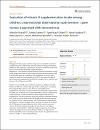Evaluation of vitamin D supplementation intake among children; cross-sectional observational study
| المؤلف | Sharafi, Niloufar |
| المؤلف | Fatima, Aiman |
| المؤلف | Gillani, Syed Wasif |
| المؤلف | Kaddour, Nour |
| المؤلف | Banoori, Rawa |
| المؤلف | Elshafie, Riham Mohamed |
| المؤلف | Rathore, Hassaan Anwer |
| تاريخ الإتاحة | 2023-05-04T07:45:10Z |
| تاريخ النشر | 2023-03-13 |
| اسم المنشور | F1000Research |
| المعرّف | http://dx.doi.org/10.12688/f1000research.123373.1 |
| الاقتباس | Sharafi, N., Fatima, A., Gillani, S. W., Kaddour, N., Banoori, R., Elshafie, R. M., & Rathore, H. A. (2022). Evaluation of vitamin D supplementation intake among children; cross-sectional observational study. F1000Research, 11, 1456. |
| الملخص | Background: The purpose of this study was to review the vitamin D supplementation intake status among children in the general public, determine the vitamin D supplements practices, and the barriers that parents and children face with supplementation. Methods: A cross-sectional observational questionnaire-based survey study design was used. A convenience sampling technique was used to collect the data. An online Rao soft sample size calculator was applied to determine the sample size of 319. The response rate of participants was expected to be 63%, the margin of error was 5% and the level of confidence was 95%. Results: A total of 248 parents (89.1% mothers (n =203)) and 15.7% fathers (n=39) with a mean ± SD age of 35.4 ± 7.04 years, completed the study (77.7% response rate). Parents reported that the supplements used the most by children were vitamin D supplements (21.85%) and multivitamins (21.8%) followed by calcium supplements (5.6%). However, 27.8% of children in this study did not take any supplements. Of all the parents, 65% (162) of them reported sending their child outside to play while 34.67% (86) of parents had reported no outdoor activity. Approximately 184 (74.2%) parents reported the child’s diet to contain multiple natural sources of vitamin D. However, 69 (27.8%) parents reported giving none of the natural sources of vitamin D to their children through the diet. Parents with higher education about 62.9% (n=156) had a higher frequency of providing vitamin D supplements to their children. Children in high-income families (43.63%) were more likely to take vitamin D supplements than those in middle- or low-income families. Conclusion: The study concluded that challenges like the educational and financial background of parents, family-income level, and health insurance status could help aid in addressing the overall burden of vitamin D deficiency among young children. |
| اللغة | en |
| الناشر | Taylor & Francis |
| الموضوع | challenges deficiency dietary sources frequency sunlight exposure supplementation Vitamin D |
| النوع | Article |
| رقم المجلد | 11 |
| ESSN | 2046-1402 |
الملفات في هذه التسجيلة
هذه التسجيلة تظهر في المجموعات التالية
-
أبحاث الصيدلة [1454 items ]


